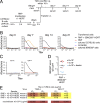HIV-specific humoral immune responses by CRISPR/Cas9-edited B cells
- PMID: 30975893
- PMCID: PMC6547862
- DOI: 10.1084/jem.20190287
HIV-specific humoral immune responses by CRISPR/Cas9-edited B cells
Abstract
A small number of HIV-1-infected individuals develop broadly neutralizing antibodies to the virus (bNAbs). These antibodies are protective against infection in animal models. However, they only emerge 1-3 yr after infection, and show a number of highly unusual features including exceedingly high levels of somatic mutations. It is therefore not surprising that elicitation of protective immunity to HIV-1 has not yet been possible. Here we show that mature, primary mouse and human B cells can be edited in vitro using CRISPR/Cas9 to express mature bNAbs from the endogenous Igh locus. Moreover, edited B cells retain the ability to participate in humoral immune responses. Immunization with cognate antigen in wild-type mouse recipients of edited B cells elicits bNAb titers that neutralize HIV-1 at levels associated with protection against infection. This approach enables humoral immune responses that may be difficult to elicit by traditional immunization.
© 2019 Hartweger et al.
Figures




References
-
- Bar K.J., Sneller M.C., Harrison L.J., Justement J.S., Overton E.T., Petrone M.E., Salantes D.B., Seamon C.A., Scheinfeld B., Kwan R.W., et al. . 2016. Effect of HIV Antibody VRC01 on Viral Rebound after Treatment Interruption. N. Engl. J. Med. 375:2037–2050. 10.1056/NEJMoa1608243 - DOI - PMC - PubMed
Publication types
MeSH terms
Substances
Grants and funding
LinkOut - more resources
Full Text Sources
Other Literature Sources
Medical
Molecular Biology Databases

